In recent years, the popularity of battery-powered electronic products has made power consumption an increasingly important issue for analog circuit designers. This article will introduce how to use low-power operational amplifiers for system design, and will also cover low-power operational amplifiers with low supply voltage capabilities and their applications, as well as discuss how to correctly understand the specifications in the operational amplifier datasheets, comprehensively considering energy-saving technologies in circuit design to achieve more efficient component selection.
Understanding Power Consumption in Operational Amplifier Circuits
First, we will discuss amplifiers with low quiescent current (IQ) and the relationship between increasing the feedback network resistance and power consumption.
Let’s first consider an example circuit that may require attention to power: a battery-powered sensor generating a 50mV amplitude and 50mV offset analog sine signal at 1kHz. The signal needs to be amplified to a range of 0V to 3V for signal conditioning (Figure 1); while conserving battery power as much as possible, this will require a non-inverting amplifier configuration with a gain of 30V/V, as shown in Figure 2. So, how should we optimize the power consumption of this circuit?

Figure 1: Input and Output Signals in the Example Circuit
(Image Source: Texas Instruments)
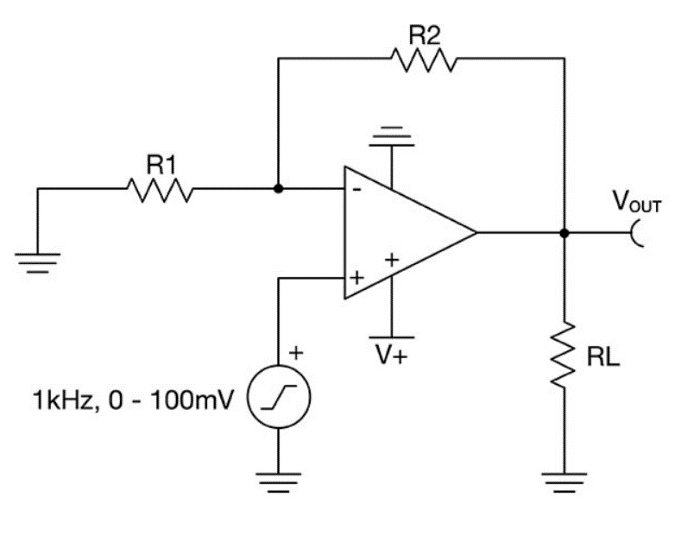
Figure 2: Sensor Amplifier Circuit
(Image Source: Texas Instruments)
Power consumption in operational amplifier circuits consists of several factors: static power, operational amplifier output power, and load power. Static power (or PQuiescent) is the power required to keep the amplifier on, typically represented by IQ in the datasheet, as shown in the Texas Instruments OPA391 datasheet below.

Figure 3: Quiescent Current of TI OPA391
(Image Source: Texas Instruments)
Output power (POutput) is the power consumed by the operational amplifier output stage driving the load. Finally, load power (PLoad) is the power consumed by the load itself.
In this example, we have a single-supply operational amplifier with a sine output signal having a DC voltage offset. Therefore, we will use the following equations to calculate the total average power (Ptotal,avg). The supply voltage is represented by V+, Voff is the DC offset of the output signal, Vamp is the amplitude of the output signal, and RLoad is the total load resistance of the operational amplifier. It is important to note that the average total power is directly proportional to IQ and inversely proportional to RLoad.
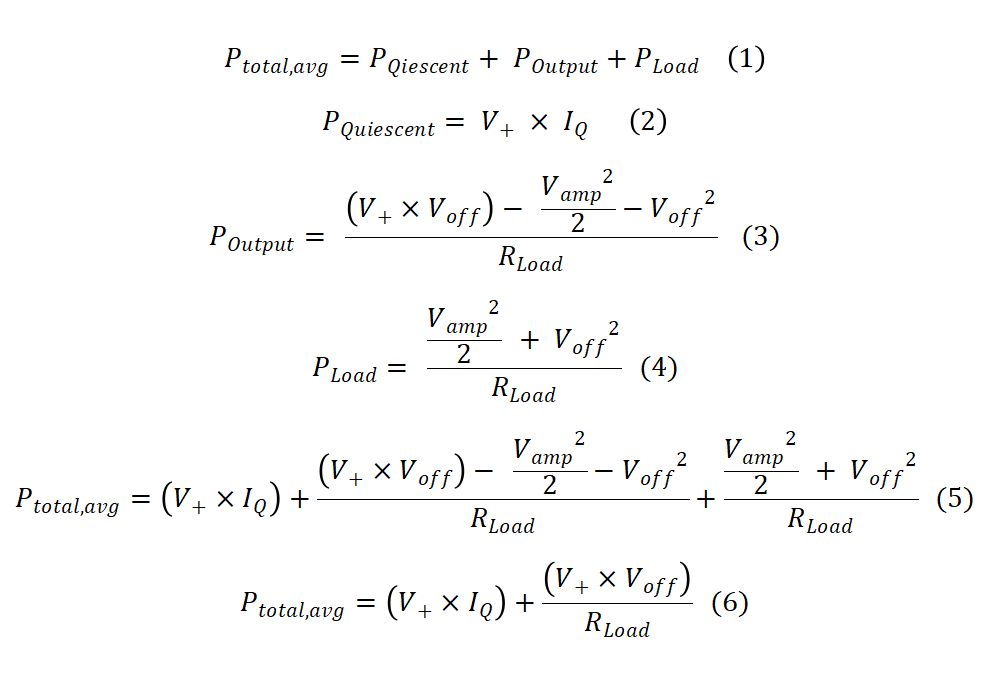
Selecting Components with Appropriate IQ Values
Since there are multiple variables in equations 5 and 6, it is best to consider only one variable when selecting components. Choosing amplifiers with low IQ is the most direct strategy for reducing overall power consumption. Of course, there are some trade-offs in this process. For example, devices with lower IQ typically have lower bandwidth, higher noise, and may be more difficult to stabilize.
Because the IQ of different types of operational amplifiers can vary by orders of magnitude, it is worth taking the time to choose the right amplifier. The following compares TI TLV9042, OPA2333, OPA391, and TLV8802. Purely from a numerical analysis, for applications requiring maximum power efficiency, TLV8802 would be an excellent choice.

Table 1: Comparison of Various Low-Power Operational Amplifiers
Reducing the Resistance Value of the Load Network
Now let’s continue to consider the remaining terms in equations 5 and 6. The Vamp term cancels out and does not affect Ptotal,avg and Voff, which are typically predetermined by the application. In other words, the system cannot use Voff to reduce power consumption.
Similarly, the V+ rail voltage is usually set by the available supply voltage in the circuit. Additionally, RLoad is also predetermined by the application. However, RLoad includes any output components of the load, not just the load resistor RL. In the case of the circuit shown in Figure 1, RLoad will include RL and the feedback components R1 and R2. Therefore, RLoad will be defined by equations 7 and 8 as follows:

By increasing the value of the feedback resistor, the output power of the amplifier in the system is also reduced accordingly. This technique is particularly effective when Poutput dominates PQuiescent, but it also has its limitations. If the feedback resistor becomes significantly larger than RL, then RL will dominate RLoad, causing power consumption to stop decreasing. Large feedback resistors can also interact with the input capacitance of the amplifier, making the circuit unstable and generating significant noise.
To minimize the noise generated by these components, it is best to compare the thermal noise of the equivalent resistance seen at each operational amplifier input (see Figure 4 below) with the voltage noise spectral density of the amplifier. A rule of thumb is to ensure that the input voltage noise density specification of the amplifier is at least three times that of the voltage noise from the equivalent resistance observed at each input of the amplifier.
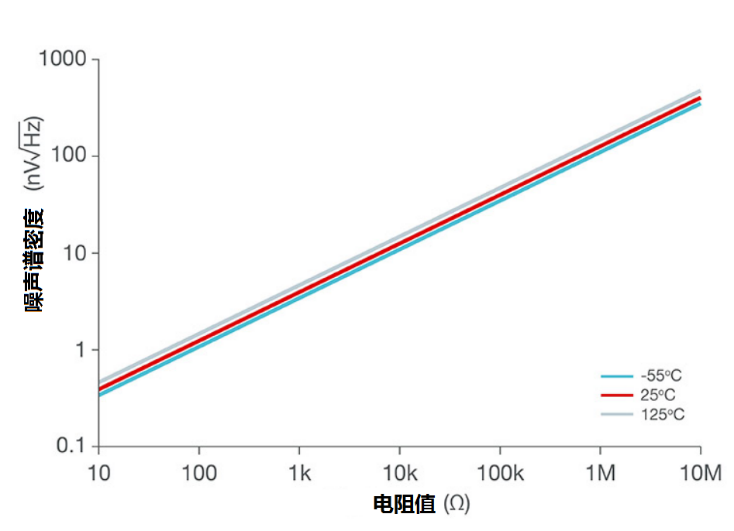
Figure 4: Thermal Noise of Resistors
(Image Source: Texas Instruments)
Using these low-power design techniques, let’s return to the original question: A battery-powered sensor generating a 0 to 100mV analog signal at 1kHz requires a 30V/V signal gain. Figure 5 compares two designs. The design on the left uses a typical 3.3V supply, resistors that do not consider energy saving, and a TLV9002 general-purpose operational amplifier. The design on the right uses larger resistor values and a lower power TLV9042 operational amplifier.
Note that when the equivalent resistance at the inverting input of the TLV9042 is about 9.667kΩ, the noise spectral density is less than one-third of the amplifier’s broadband noise, ensuring that the noise of the operational amplifier dominates any noise generated by the resistor.
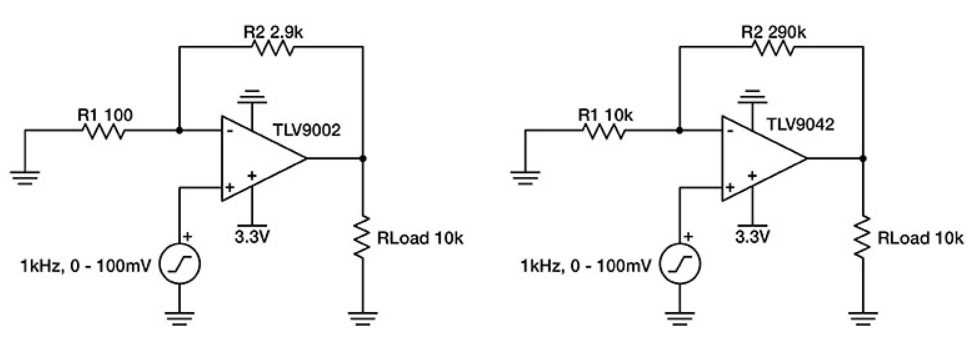
Figure 5: Typical Design vs. Fine-Tuned Design
(Image Source: Texas Instruments)
Using the values, design specifications, and the specifications of the two operational amplifiers in Figure 5, we can use equation 6 to derive Ptotal,avg for the TLV9002 design and the TLV9042 design, respectively. The results are shown in equations 9 and 10.
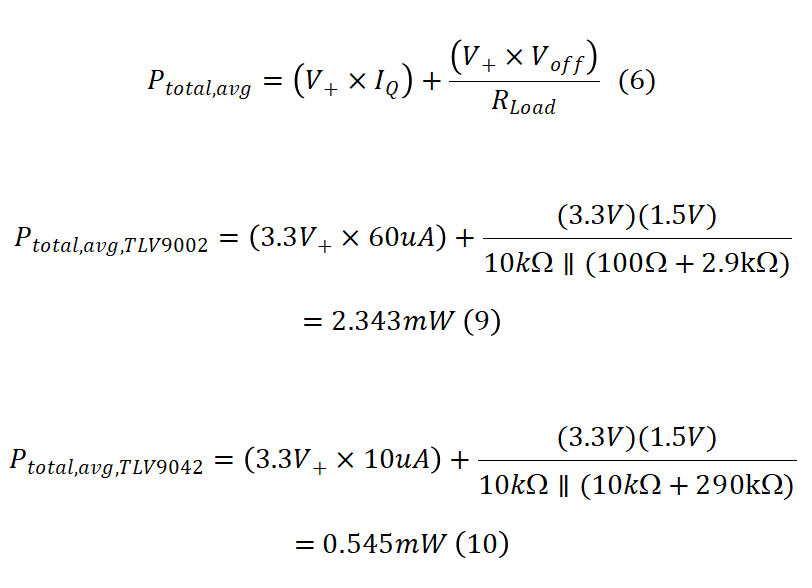
From the above results, it can be concluded that the power consumption of the TLV9002 design is more than four times that of the TLV9042 design. This is a result of the higher amplifier IQ, which also shows that using operational amplifiers with high IQ, even when attempting to use low feedback resistor values, will not yield significant power savings. In the above example, we have two techniques: increasing the resistor values and selecting operational amplifiers with lower quiescent current. Both strategies are applicable in most operational amplifier applications.
Saving Power with Low Voltage Rails
Let’s revisit equations 1 and 6 that define the average power consumption of a single-supply operational amplifier circuit with sine signals and DC offset voltages:
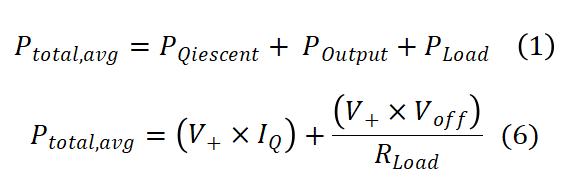
Additionally, from equation 6, V+ represents the supply rail voltage (V+), which is directly proportional to power consumption, so setting the supply rail (V+) to the lowest available supply voltage in the circuit is also a method to reduce power consumption.
Many operational amplifiers have a minimum supply voltage range of 2.7V or 3.3V. This limitation is due to the minimum voltage required to keep the internal transistors within their desired operating range. Some operational amplifiers are designed to work at voltages as low as 1.8V or even lower. For example, the TLV9042 general-purpose operational amplifier can operate at a 1.2V rail.
Battery-Powered Applications
Most modern sensors and smart devices are battery-powered, and the terminal voltage of the battery decreases during discharge. For example, the nominal voltage of an alkaline AA battery is 1.5V. The actual terminal voltage may be close to 1.6V during the first no-load measurement. As the battery discharges, the terminal voltage drops to 1.2V or even lower.
Using operational amplifiers that can work at voltages as low as 1.2V instead of amplifiers requiring higher voltages offers the following advantages:
1. The operational amplifier circuit will continue to work longer, even as the battery approaches the end of its charge cycle and its terminal voltage drops.
2. The operational amplifier circuit can operate with a 1.5V battery without the need for two batteries to form a 3V supply rail.
To understand why operational amplifiers with lower operating voltages can achieve longer battery life, consider the battery discharge curve shown in Figure 6. Batteries typically exhibit a discharge cycle similar to this curve. The terminal voltage of the battery will start to approach its nominal value. As the battery discharges over time, the terminal voltage gradually decreases. Once the battery is close to the end of its charge, the terminal voltage will drop rapidly. If the operational amplifier circuit is designed to operate only at voltages close to the battery’s nominal voltage, such as V1, the operating time t1 of the circuit will be short. However, using an operational amplifier that can work at slightly lower voltages, such as V2, can significantly extend the battery operating time t2.
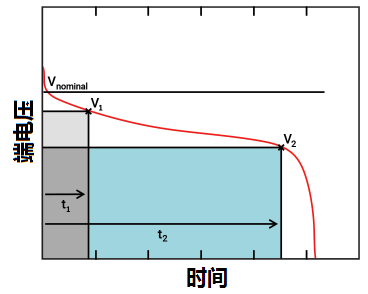
Figure 6: Typical Discharge Curve of a Single Battery
(Image Source: Texas Instruments)
Although this effect can vary depending on the battery type, load, and other factors, it is clear that operational amplifiers with low operating power have longer operational times.
Low Voltage Digital Logic Levels
Applications using low voltage rails for both digital and analog circuits can also benefit from low-power operational amplifiers with low supply voltage capabilities. Digital logic has standard voltage levels ranging from 5V to 1.8V and below (Figure 7). Like operational amplifier circuits, digital logic becomes more energy-efficient at lower voltages. Therefore, lower digital logic levels are often preferred.
To simplify the design process, you can choose to use the same supply voltage levels for your analog and digital circuits. In this case, operational amplifiers with 1.8V capability (such as high-precision, wide-bandwidth OPA391 or cost-optimized TLV9001) can prove advantageous. However, it is important to ensure that any noise that may leak from the digital circuit to the analog device power pins is eliminated if the design is to be applied to a 1.2V digital rail.
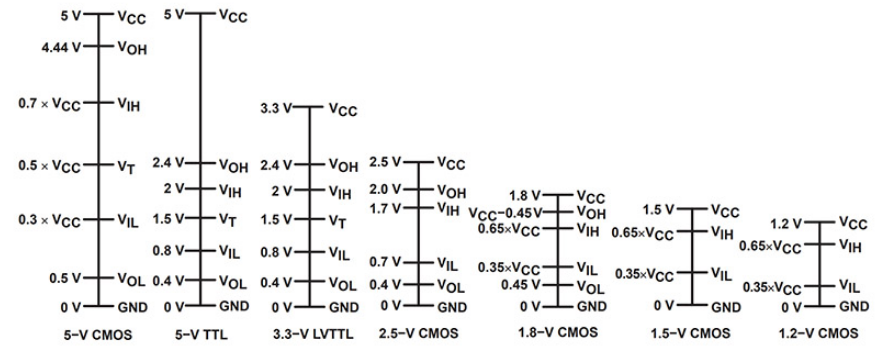
Figure 7: Standard Logic Levels
(Image Source: Texas Instruments)
Digi-Key’s Op-Amp Parameter Selection Tool
When engineers design low-power operational amplifiers for systems, Digi-Key’s parameter selection tool can assist engineers in component selection, for example: “Current-Power” can help engineers understand the current required by the operational amplifier; “Voltage-Power, Single/Dual (±)” refers to the low supply rail requirements described in the article, where engineers can clearly see the supply rail and quickly complete the selection.
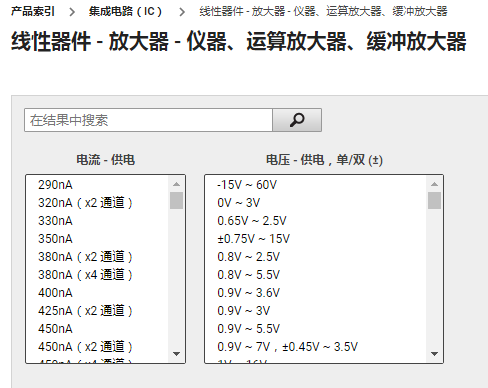
Figure 8: Digi-Key Op-Amp Parameter Selection Tool
In this article, we introduced how to quickly identify operational amplifiers that provide low power characteristics using the specifications of operational amplifiers. These methods include selecting operational amplifiers with low quiescent current within the allowable bandwidth, as well as choosing larger resistor values in the feedback circuit. Choosing to use low voltage rails and low voltage digital logic levels are also two additional factors to consider for ensuring low power in operational amplifiers.
For more technical information about operational amplifiers, please visit digikey.cn for the following related content, and feel free to leave comments and discuss on the technical forum at digikey.cn.
-
Basics of Operational Amplifiers
-
Selecting Operational Amplifiers Using DK Parameter Search
-
How to Calculate the Required Slew Rate for Operational Amplifiers
-
Inverting Output Voltage of Operational Amplifiers














